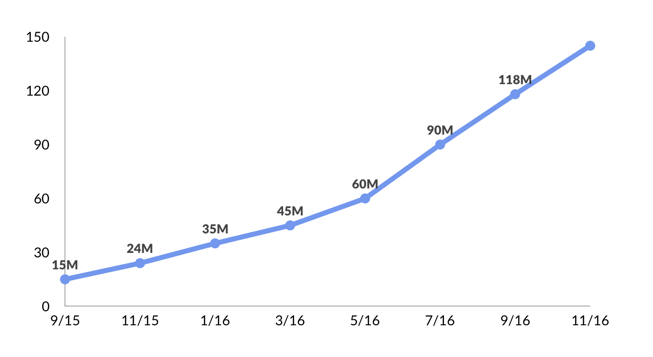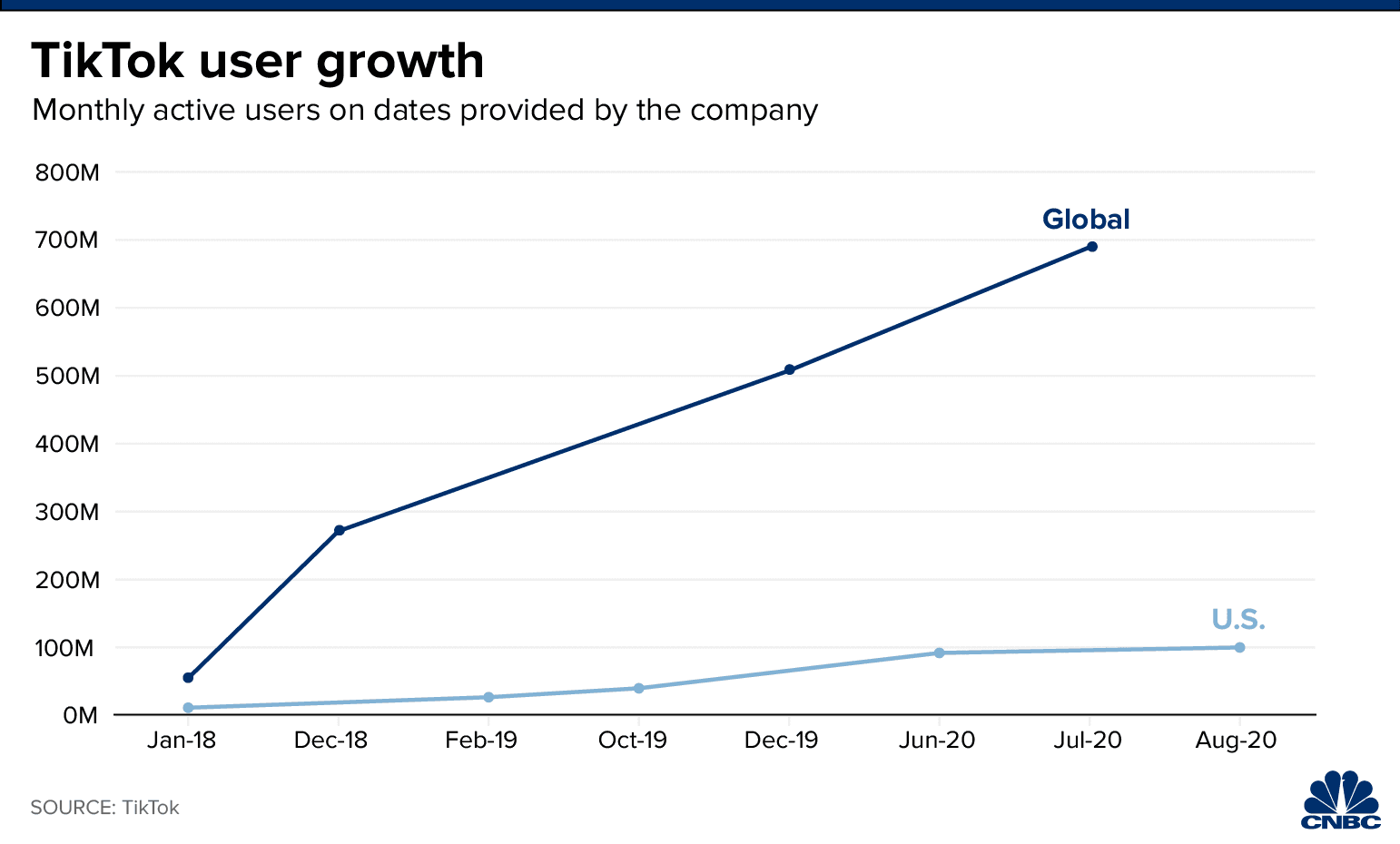Short-form video app and social media platform Musical.ly lived a relatively short life, from its launch in 2014 to its acquisition in 2017 and eventual shutdown in 2018.
Despite its short lifespan, Musical.ly accumulated more than 200 million users during its active years and received millions of video uploads each day, leading many people to wonder what exactly happened to Musical.ly and ask why it shut down if it was so popular.
The short answer is that it was folded into TikTok, which is currently the world’s most popular video-sharing app.
But an app doesn’t just go from an idea to getting acquired and merged with TikTok overnight, so let’s take a look at the origins of Musical.ly and see how it reached its eventual end.
Officially launched in August of 2014, Musical.ly was a video-based social media platform that allowed users to share and view short video clips from 15 seconds to one minute long.
Users could select from different songs to add as soundtracks to their videos, and the app helped give rise to the popular lip-sync video trend.

Like other popular social media platforms, Musical.ly’s millions of users could follow different accounts, like, comment on, and share other users’ content.
Musical.ly was headquartered in Shanghai, China, but gained a large following internationally, especially in the US. It was particularly popular with pre-teen and teenage girls.
Musical.ly was eventually acquired by TikTok’s parent company, ByteDance, on November 9, 2017, for a whopping sum of between $800 million and $1 billion.
ByteDance originally stated that Musical.ly would continue to operate as an independent app. However, they shut Musical.ly down not long after the acquisition, in August of 2018 — we’ll go into more detail on Musical.ly getting shut down below.
But before we take a closer look at what happened to Musical.ly, let’s back up and see who founded Musical.ly and how the platform got its start to better understand why it eventually got acquired and shut down.
Musical.ly was founded by Alex Zhu and Luyu Yang, a pair of Chinese entrepreneurs who met at eBaoTech, a digital solutions provider for the global insurance industry.
Zhu had graduated from China’s Zhejiang University, where he earned a bachelor’s degree in civil engineering, and worked in various tech industry jobs in China and the US before joining eBaoTech and linking up with his co-founder Yang.
Zhu’s original startup idea was for a different short-form video app called Cicada, which was intended for sharing educational video content.
Zhu and Yang were initially able to raise $250,000 from Hong Kong-based VC firm ChinaRock Capital Management to start working on their idea. But the idea for Cicada had some problems, specifically with the way users had to create videos, and it never took off.
So, as many co-founders do, Zhu and Yang pivoted from their original idea and came up with a new idea for a video-based app that combined music, video, and social media.
At this point, Musical.ly’s creators had less than 10% of their seed funding left, and they created the first version of Musical.ly in just 30 days, unofficially releasing their MVP in July of 2014. The official version launched the following month.
Even though its co-founders created the app in China, they always had their sights set on the US market, mainly because Zhu believed that Chinese teens were too busy to focus on social media apps and didn’t have the same internet browsing culture as US teens did.
With the limited funding they had left, Zhu and Yang had to make some crucial decisions about Musical.ly’s direction to try and succeed early on.
One decision that turned out to be the right one was to focus on lip-syncing content, which was particularly popular due to the TV show Lip Sync Battle that premiered shortly after Musical.ly launched.
After the co-founders made a few tweaks to the functionality of their app and pivoted towards emphasizing its lip-syncing features, Musical.ly started experiencing exponential growth.
By the summer of 2015, about a year after launching, Musical.ly was in the number one spot in the App Store, and Musical.ly’s founders were rewarded with another $16.6 million in funding from venture capitalists.
With the new injection of funding and continued organic growth, Musical.ly reached 40+ million users by the end of 2015.
In May of the following year, less than two years after the app’s launch, Musical.ly raised another $133.5 million in funding and was valued at an impressive $550 million.
At the end of 2016, Musical.ly had more than tripled its number of users to approximately 130 million, of which there were 40 million monthly active users.

By this time, Musical.ly had already launched a second app called live.ly, which was a spinoff of Musical.ly for streaming live videos.
The company launched a third app in early 2017, called Ping Pong, for group video chatting.
Another thing that happened in early 2017 was that Musical.ly partnered with Apple Music on its music catalog.
Around the same time, the Musical.ly team also decided to stop focusing on only lip sync content and shift to being an app for all types of videos.
To support this pivot, Musical.ly partnered with several major broadcasting networks, including Hearst and Viacom, to release original content on the platform.
In August 2017, Musical.ly received a significant redesign with a new emphasis on feed personalization and customization.
However, a few months later, the company announced that it had been sold to TikTok’s parent company, ByteDance.
ByteDance did not shut down Musical.ly right away, and the app continued to function as normal until August of 2018, when ByteDance suddenly announced that it would be merging Musical.ly into TikTok, thus ending its four-year run.
Musical.ly was available on Android and iOS and allowed users to record videos from 15 seconds to one minute long, in one or multiple shots. They could add soundtracks using songs or other background tracks, such as comedic sound effects.
From early on, Musical.ly’s emphasis was on lip-syncing, and users could choose from thousands of songs to set their recordings to.
This was due to Musical.ly partnering with major record labels, such as Warner Music Group, to allow their music to be licensed for use on the Musical.ly platform.
When Musical.ly partnered with Apple Music in 2017, users could cut 15-second clips from songs streamed via Apple Music and use them for their Musical.ly videos.

Other features of Musical.ly included adding pre-set filters to videos, changing the speed of videos, and reversing the recording motion, among other standard editing features.
Musical.ly also focused mainly on the user experience regarding what videos they saw on their feeds. The app featured various video categories, trending videos, song charts, and leaderboards that showed what soundtracks were most popular at any given time.
Users could also share their videos across other social media platforms, including Facebook and Instagram.
All videos created using Musical.ly had a watermark of the company’s logo in them, which was one of the brand’s early marketing strategies that helped them grow through cross-exposure on more popular social platforms.
Interestingly, users were cropping out the Musical.ly watermark when they cross-shared videos early on, which caused the Musical.ly team to change the position of the watermark. This seemingly small decision likely had a significant impact on the brand’s early exposure.
Musical.ly was the preferred platform of many social video content influencers, and the company manually verified popular users and awarded their profiles with crowns to show they had been verified.
Some extremely popular TikTok content creators, such as Ariel Martin and Loren Gray, got their start on Musical.ly.
These influencers gained the followings of millions on Musical.ly for their lip-syncing videos and even garnered media attention, landing interviews on shows such as Good Morning America.
When Musical.ly merged with TikTok, many of its features were incorporated or reworked into TikTok. They also provided performance analytics to users to help former Musical.ly influencers continue to succeed on TikTok.
As we mentioned earlier, Musical.ly was merged into TikTok about a year after it was acquired by ByteDance.
According to a representative of ByteDance, these were the original plans for Musical.ly:
“Musical.ly will continue to operate as an independent platform, integrating ByteDance’s global leading [artificial intelligence] technology and leveraging its reach in China and key markets across Asia to enhance Musical.ly’s offering to users, creators, and partners.”
However, ByteDance ultimately decided that it made the most sense to consolidate Musical.ly and TikTok users into a single app, so they chose to be TikTok.
All of Musical.ly’s users and content were migrated over to TikTok, making the sudden closure of Musical.ly and its merging into TikTok a smooth transition.
TikTok also incorporated some of Musical.ly’s popular features into the new and improved app, including a feed that showed users personalized content based on their viewing preferences and history.
Musical.ly's content and users smoothly transitioned to TikTok, retaining features like a personalized content feed. Despite some influencers' criticism over the abrupt change, TikTok's popularity soared, becoming the U.S.'s top app in 2018 and amassing over 750 million monthly active users globally.

But what happened to Musical.ly’s co-founders after Musical.ly shut down? Well, both Zhu and Yang stayed with ByteDance after the acquisition and continued to work with the company on TikTok after their project was merged into it.
Zhu made the following statement about the merger:
“Combining Musical.ly and TikTok is a natural fit given the shared mission of both experiences — to create a community where everyone can be a creator.”
The main reason why ByteDance decided to shut down Musical.ly and combine it with TikTok was to take advantage of its user base and technology.
At the time of the merger, TikTok was very popular in China but struggled to expand into foreign markets. As we discussed above, Musical.ly did the opposite and was very popular in international markets, especially in the United States.
So, rather than split resources between two very similar apps with different markets, it made the most sense for ByteDance to simply fuse them and combine their hundreds of millions of users into one platform.
By merging the two popular video-sharing platforms, ByteDance could focus all its resources on marketing and developing just one platform.
It’s also likely that ByteDance saw merging the two user bases as a way to be more competitive with other social media giants, such as Facebook, that were also growing in terms of video sharing.
In short, the acquisition and shutdown of Musical.ly was a mutually beneficial deal that allowed ByteDance to accelerate TikTok’s growth into one of the world’s most popular social media platforms.
The first version of the app was officially launched in August 2014.
Musical.ly was shut down in mid-2018 after being acquired by ByteDance, which is the company that owns TikTok.
The company was shutdown because the new owners, Bytedance wanted to incorporate its technology and userbase into TikTok.
Bytedance merged the user accounts of Musical.ly in August 2018.
Musical.ly is not a failed startup — it didn’t shut down because of doing anything wrong. In fact, Musical.ly is a prime example of a company that did everything right.
Like many startup founders, Musical.ly’s co-founders had to pivot from their initial idea to finding one that worked, and they seem to have done so at just the right time.
In the case of Musical.ly, the co-founders were able to capitalize on the popularity of social media and lip-syncing videos with the teen and pre-teen markets, particularly in the United States, and their app really took off running.
Because of its massive success in just a few years, Musical.ly caught the eye of its competitors, and the company was able to close a very lucrative acquisition deal with ByteDance.
Musical.ly’s co-founders were even able to continue working on their product in its new form as part of TikTok, and parts of Musical.ly live on through the massively popular social video-sharing platform.
